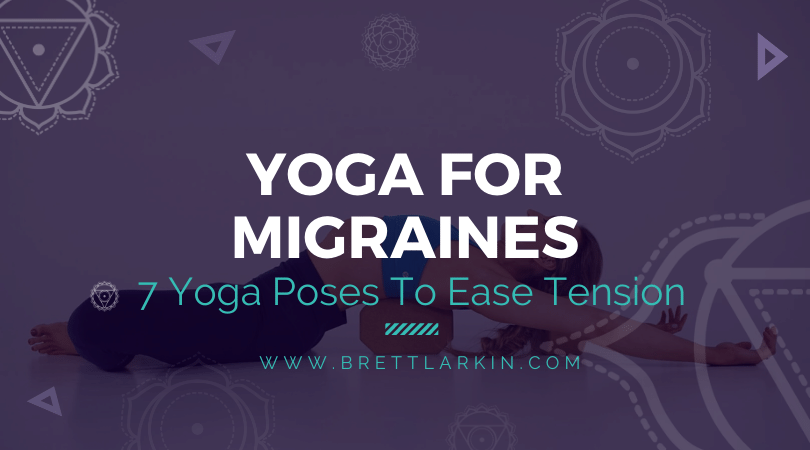
If you’ve ever had a migraine, then you’ve likely tried all sorts of remedies. From turning down the lights to rubbing essential oils across your forehead, no remedy every seems to work quite enough.
And when you’re deep in the pain, you want help FAST.
The worst part is that you’re not alone. Migraines are a common neurological health condition which affects roughly 1 in 5 women, and approximately 13% of the global population.
Migraines are a type of headache, which is accompanied by varied intensity and symptoms. Migraines tend to be recurring, and can often be extremely painful. During a migraine, symptoms such as moderate to severe pain, nausea, vomiting, sensitivity to light and sound can occur.
While there are tons of pharmaceutical medications to stop a migraine in its tracks, yoga can be used to help either prevent them from occurring or reduce their severity by easing tension in the muscles around the shoulders, neck, and base of your skull.
So I’m sharing my favorite tips for reducing migraines in this post. Of course, always consult your trusted medical professional in case of emergency and never push your body beyond what feels comfortable.
Which Types of Yoga Are Best For Migraines?
Yoga is an ancient practice that has many associated health benefits. A research study conducted on the effects of Yoga and Yoga Therapy as a migraine treatment found that Yoga is an effective way to manage the frequency and intensity of migraine headaches. The study concluded that Yoga Therapy produces helpful effects on the nervous system, which in turn may help patients with migraine pain.
The best types of Yoga to support migraine pain relief are those which enable deep breathing and meditation:
- Gentle Hatha Yoga – great for migraine due to its focus on gentle activity and deep breathing
- Yin Yoga – helps to relieve headaches due to the focus on relaxation and meditation
- Restorative Yoga – great for migraine due to the focus on tension and stress releasing poses
7 Best Yoga Poses For Migraines
It is better to cultivate a regular yoga practice that may support the prevention, rather than the treatment, of headache symptoms.
Practicing yoga regularly helps to improve quality of life, physical well-being, along with overall health.
By regularly taking the time to practice Yoga as a gentle nourishing exercise for both the body and mind, we can improve our health by combating stress, which has a large impact on the nervous system and blood pressure.
While medical treatment mainly deals with the symptoms of migraine pain once it has arrived, Yoga may be able to provide headache sufferers with an alternative route for migraine management which can help to prevent a headache even occurring. Yoga pairs well with other natural remedies that can help treat a migraine attack in real time, like using peppermint oil, consuming magnesium and multivitamins, or wearing migraine glasses.
If your migraines are severe and persistent, it is always advised to seek medical advice along with any alternative therapies you may be exploring.
When using Yoga to prevent or relieve the pain experienced during a migraine attack, always take the care to move slowly, try closing the eyes in every Yoga asana and feel the breath flowing smoothly and deeply. Utilize the breath to help remove any stress you find within the body, see if you can send each exhale to any areas of tension.
Here are some new yoga poses for you to incorporate which you may find to help prevent headaches being triggered, along with possibly reducing the pain intensity of those that do occur.
1. Pose #1 (Reclined Pigeon Pose – Supta Kapotasana)
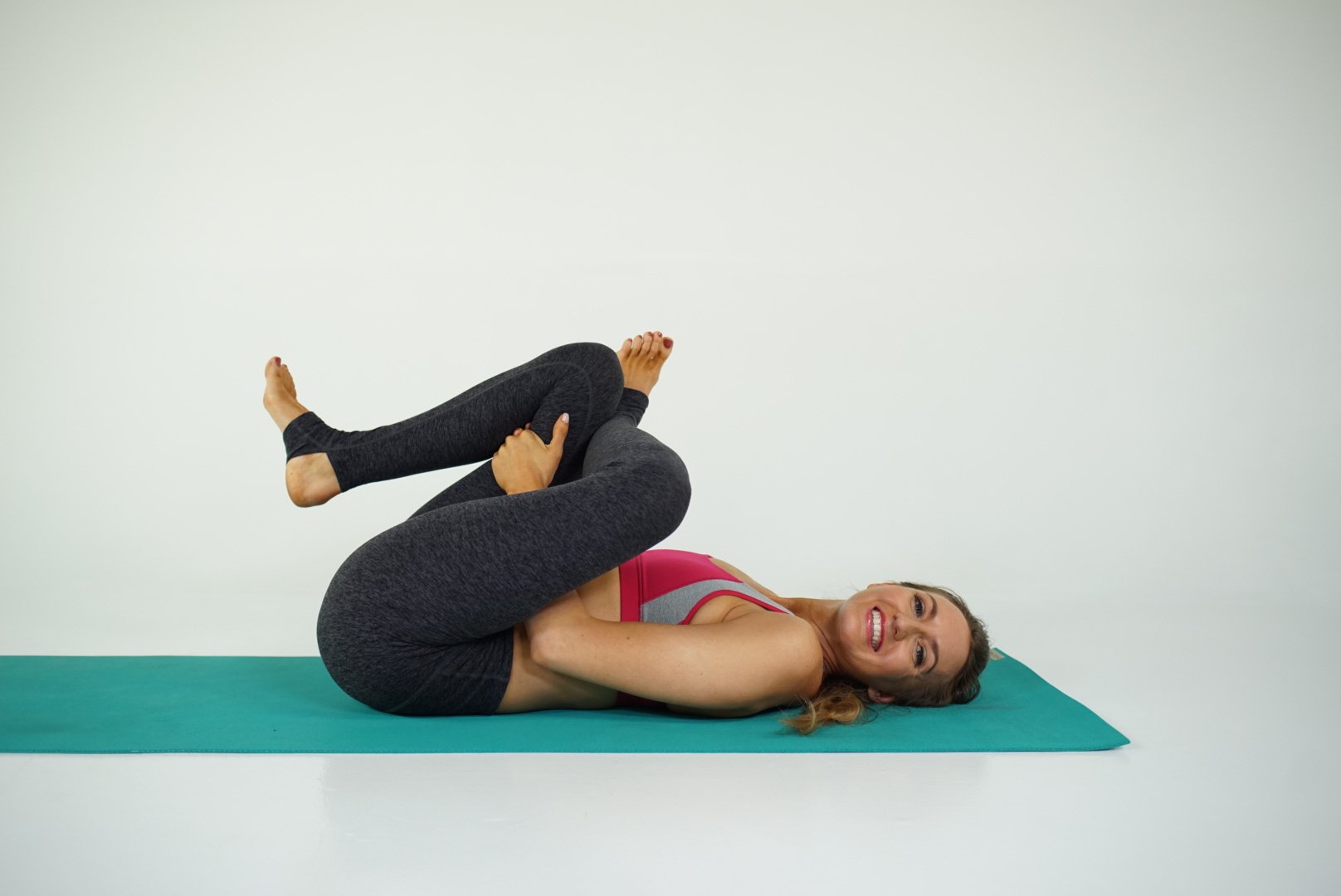
- Step 1: Lay flat on the mat with the spine fully grounded. Bend the knees, and place the feet hip-distance apart on the floor.
- Step 2: Lift the right foot, and cross it over the left thigh, just above the left knee.
- Step 3: Reach the right arm through the legs and clasp the hands behind the left thigh or in front of the left shin.
- Step 4: With an exhale, draw the left leg in towards the body. Make sure that the shoulders and spine are fully grounded.
- Step 5: Close the eyes, hold the posture, focus on relaxing the muscles, along with long deep breaths. Repeat on both sides.
Variation: Hook a Yoga strap around the middle arch of the left foot, and use this to draw the left leg in towards the torso.
Benefits: Reclined Pigeon is an amazing Yoga posture that combines relaxation with deep stretching. Due to its restorative nature, it may help to balance blood pressure and provide migraine pain relief.
2. Pose #2 (Child’s Pose – Balasana)
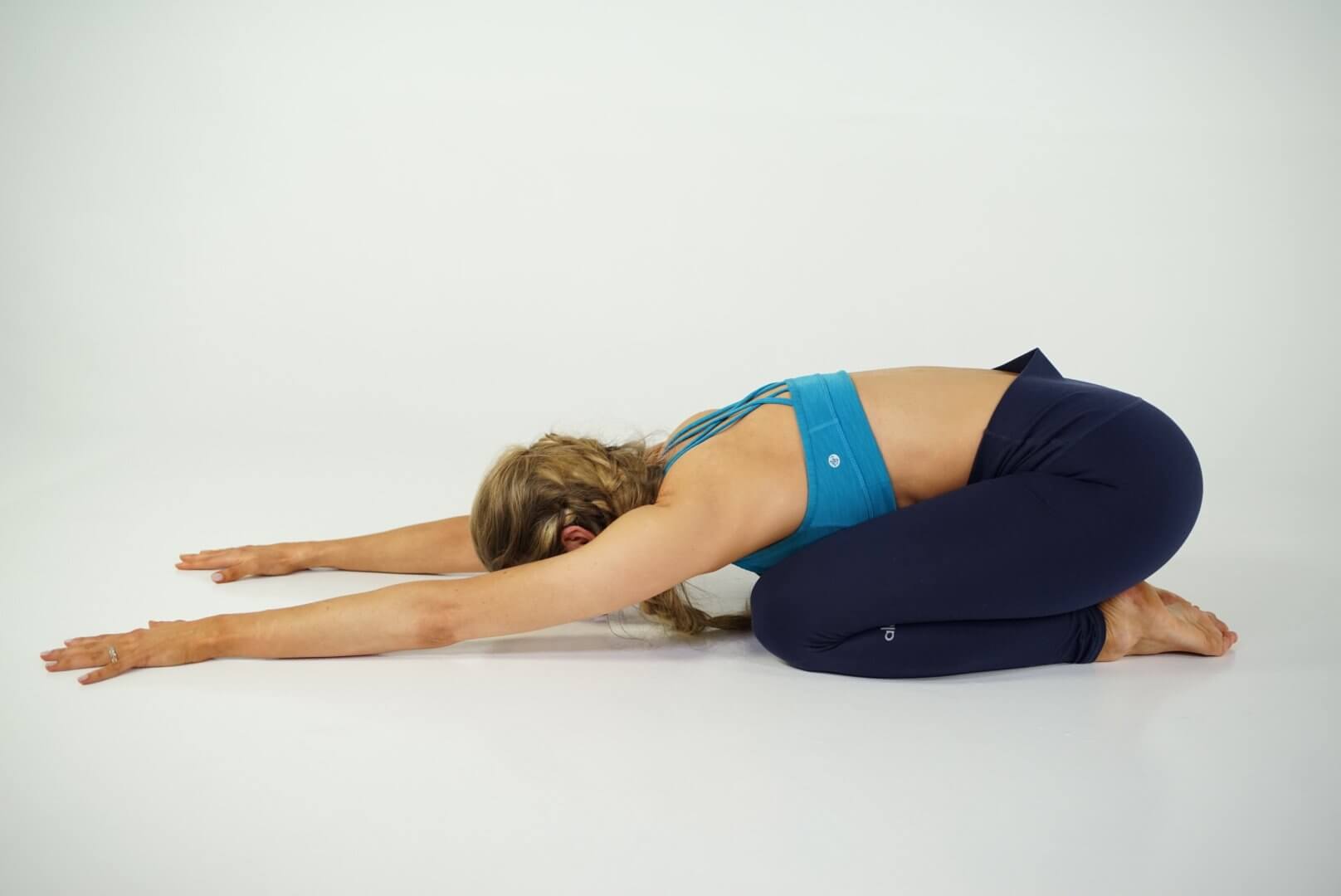
- Step 1: Kneel on the mat with the knees hip-distance apart, and sit back onto your heels.
- Step 2: Exhale and slowly walk the hands forward until they are fully extended, and the torso is rested on the thighs.
- Step 3: Close the eyes, focus on long deep breaths combined with muscle relaxation. Allow the Yoga mat to fully support your weight as you melt into the ground.
Variation: If you find this doesn’t feel comfortable, experiment with opening the knees. Allowing the torso to rest in between the thighs, rather than on top of them.
Benefits: Allowing yourself to fully surrender to this Yoga posture. Child’s pose is an amazing restorative posture to alleviate stress, and anxiety. Due to the calming nature of the posture, it can help to relieve headache tension and pressure experienced during a migraine attack. Balasana physically works on lengthening the spine, and releases tension in the upper back.
3. Pose #3 (Reclined Spinal Twist – Supta Matsyendrasana)
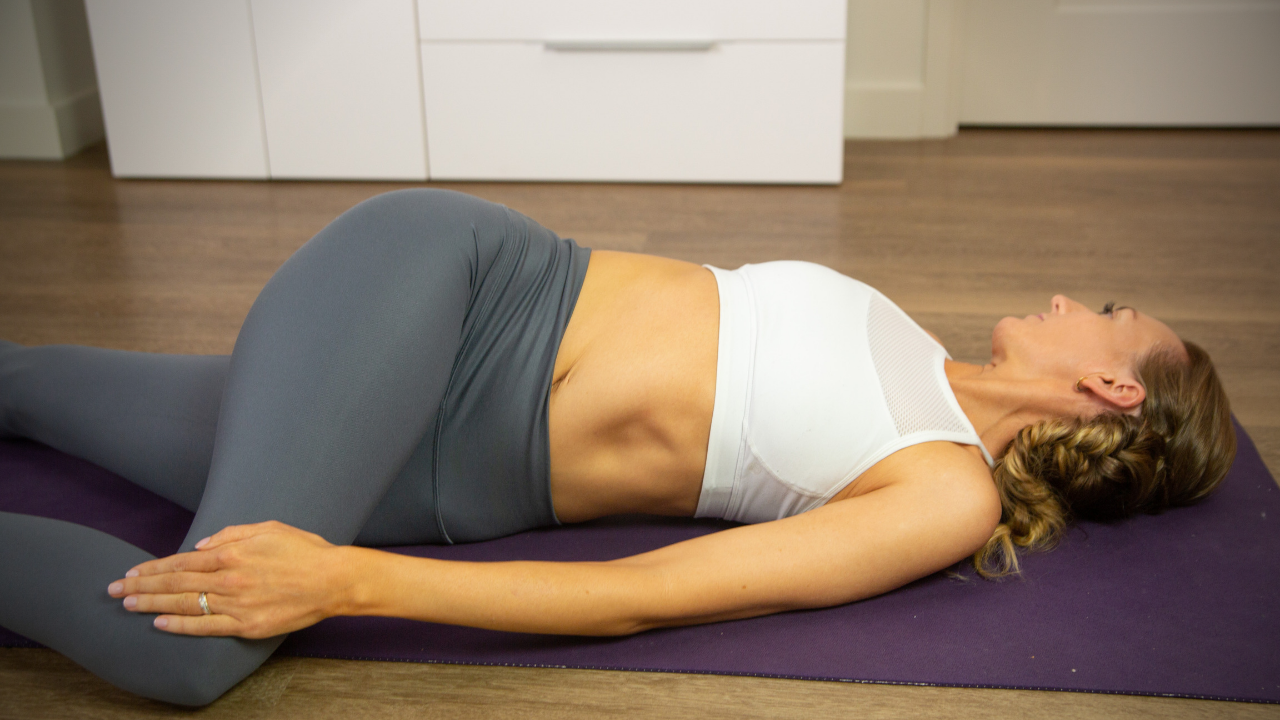
- Step 1: Lay comfortably on your back on the mat, and outstretch the arms, into a “T” shaped position. Extend fully through the spine and lengthen the body
- Step 2: Bend the left knee, exhale, and draw the left knee over the right leg, towards the floor. If the knee doesn’t rest on the floor, use a bolster underneath.
- Step 3: Keep both shoulders fully grounded, and turn the head to look over the left shoulder.
- Step 4: Close the eyes, fully relax into the posture, breathe deeply and allow yourself to melt into the mat. Repeat on both sides.
Variation: Bend both knees and bring them simultaneously to the floor. If you find the shoulders lifting from the floor, try using a bolster under the knee to soften the twist.
Benefits: Reclined spinal twist is a wonderful Yoga posture that encourages lengthening of the spine, and full relaxation. Allow yourself to fall into a meditation with the breath to produce a calming effect on the nervous system, this helps to balance blood pressure, which aids in the healing of migraines.

4. Pose #4 (Happy Baby Pose- Ananda Balasana)
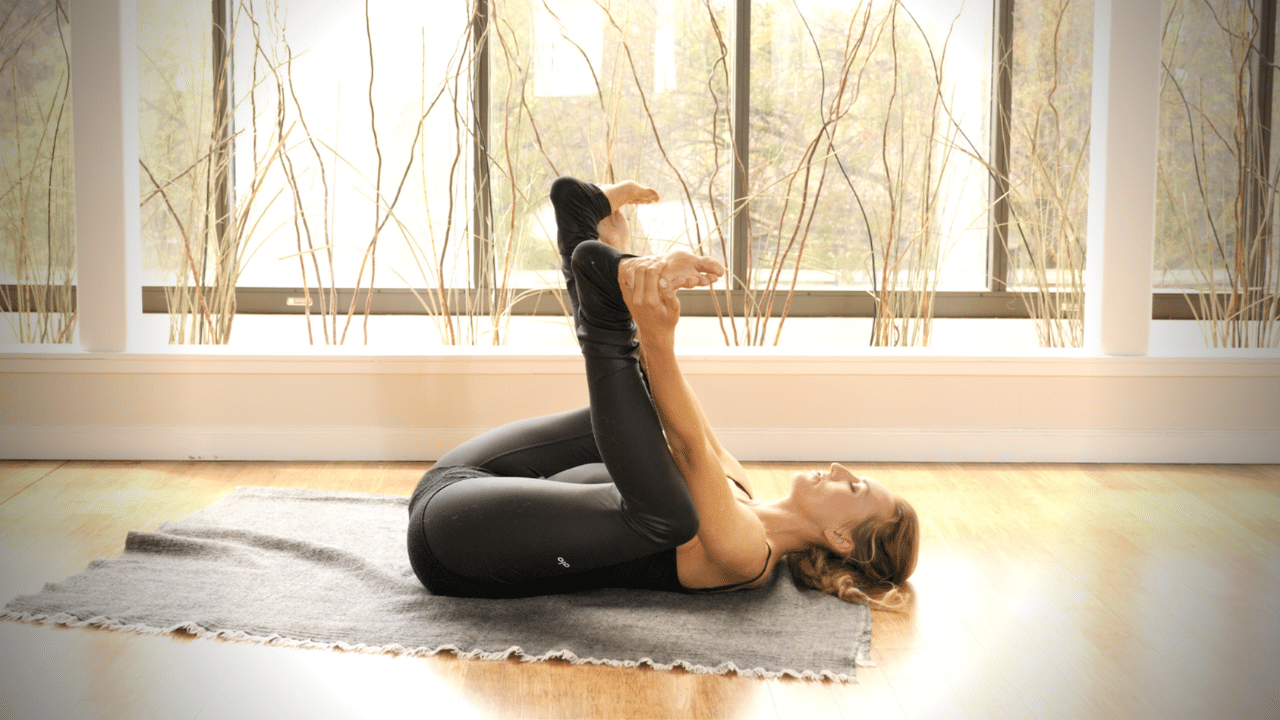
- Step 1: Lie comfortably on your back.
- Step 2: With an exhale draw the knees in towards the chest, allowing them to rest either side of the torso.
- Step 3: Take an inhale, and hold each foot from the outer edge. With an exhale draw the knees closer towards the armpits. Keep the spine, tailbone and shoulders fully grounded on the Yoga mat.
- Step 4: Close the eyes, relax into the asana and allow gravity to draw the hips open. With each exhale allow the hips to open and release.
Variation: You can also use a strap to reach for the feet, try positioning the strap in the middle arch of each foot and use the strap to gently draw the knees towards the torso.
Benefits: Happy baby pose lengthens the spine, and opens the chest. By allowing extra space for the torso, we give space to the heart and lungs, this results in an optimal environment for blood pressure to balance therefore reducing stress and migraine symptoms.
Want to see more yoga poses? Check out my Yoga Pose Directory
5. Pose #5 (Reclined Butterfly Pose- Supta Baddha Konasana)
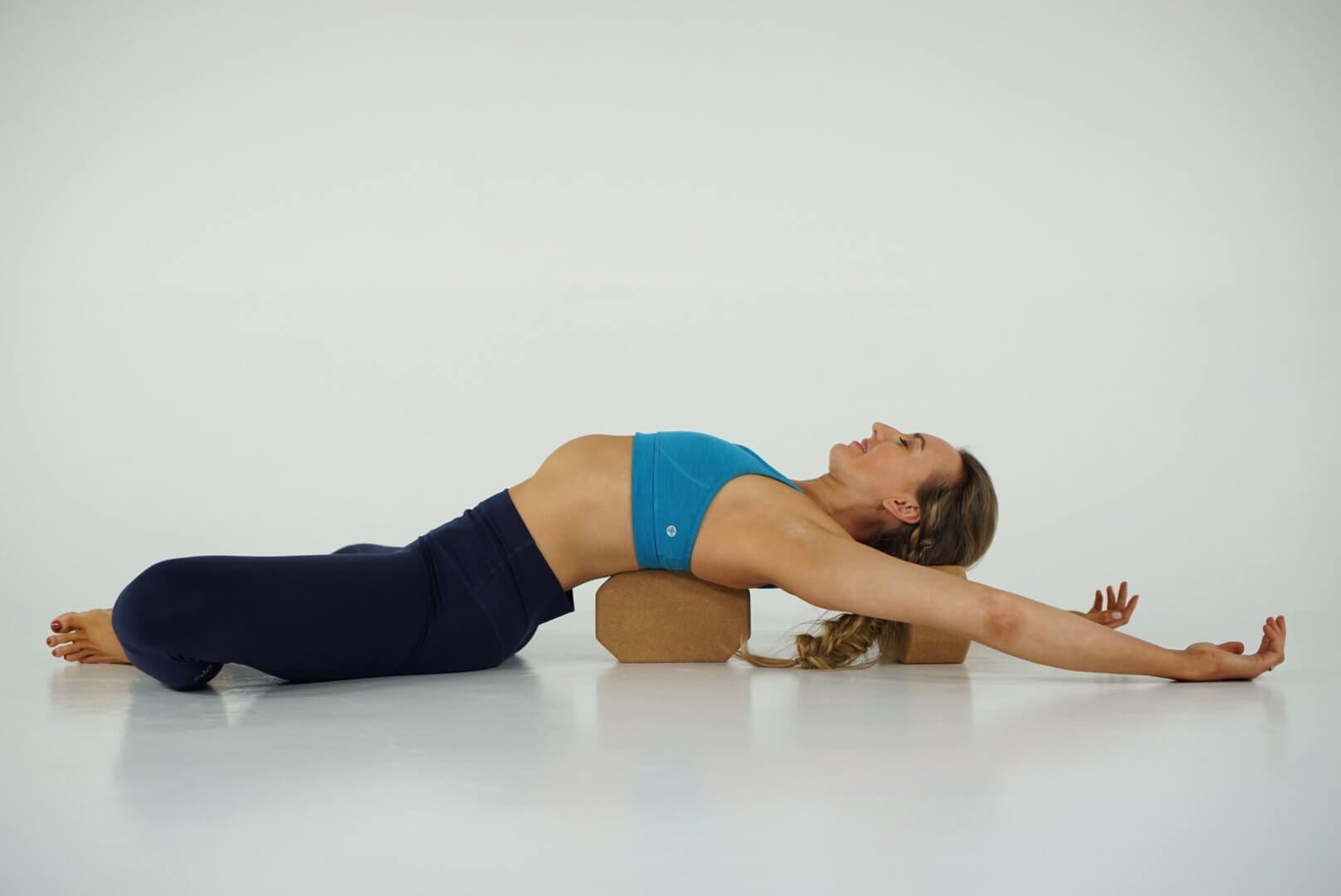
- Step 1: Lay comfortably on your back. Exhale and bend the knees.
- Step 2: Bring the feet together, and allow the knees to gently fall outwards towards either side of the Yoga mat. Keep the soles of the feet together and the spine fully grounded.
- Step 3: Fully relax the arms either side of the body, and keep the palms facing upwards.
- Step 4: Close the eyes, allow the exhale to release any tension from the inner thighs and back, focus on steady breathing, and full body relaxation.
Variation: If there is space in between the knee and the floor, it may feel better to place a bolster under each knee to provide them with support.
Benefits: Reclined Butterfly is a restorative Yoga posture that helps to improve blood flow, it also enables the release of tension and stress which can positively impact the pressure experienced during headaches. By setting up in a comfortable position with props and bolsters, we provide space for the heart, and deep breathing. Full relaxation during a migraine attack in a suitable Yoga asana can provide relief for migraine pain.
6. Pose #6 (Seated Spinal Twist – Ardha Matsyendrasana)

- Step 1: Sit upright on the Yoga mat, position yourself just in front of the sit bones so that you are fully grounded and stable. Fully extend the legs out in front of you.
- Step 2: Bend the right knee and cross the right foot over the left leg. Position the right foot just outside the left knee.
- Step 3: Bend the left knee, and draw the left foot to the right hip, keeping the left leg on the mat. Keep the right foot, and the hips equally grounded, and square off the hips with the short side of the Yoga mat.
- Step 4: Place right hand behind your sacrum for support. Lift the left arm, inhale, lengthen the spine through the crown of the head, and exhale gently twisting towards the right knee.
- Step 5: Hook the left elbow on the outside of the right knee to support the twist, and look over the right shoulder.
- Step 6: Practice with the eyes closed, and maintain the length through the spine. Focus on steady, deep breathing and stillness within the mind. Repeat on both sides.
Variation: Keep the left leg extended and the foot flexed if there is any discomfort in the knee.
Benefits: Seated spinal twist stimulates blood circulation to the organs . Ardha matsyendrasana provides mobility to the back and neck, and supports the release of any stiffness, which can often be experienced during headache and migraine.
7. Pose #7 (Head to Knee Pose – Janu Shirshasana)
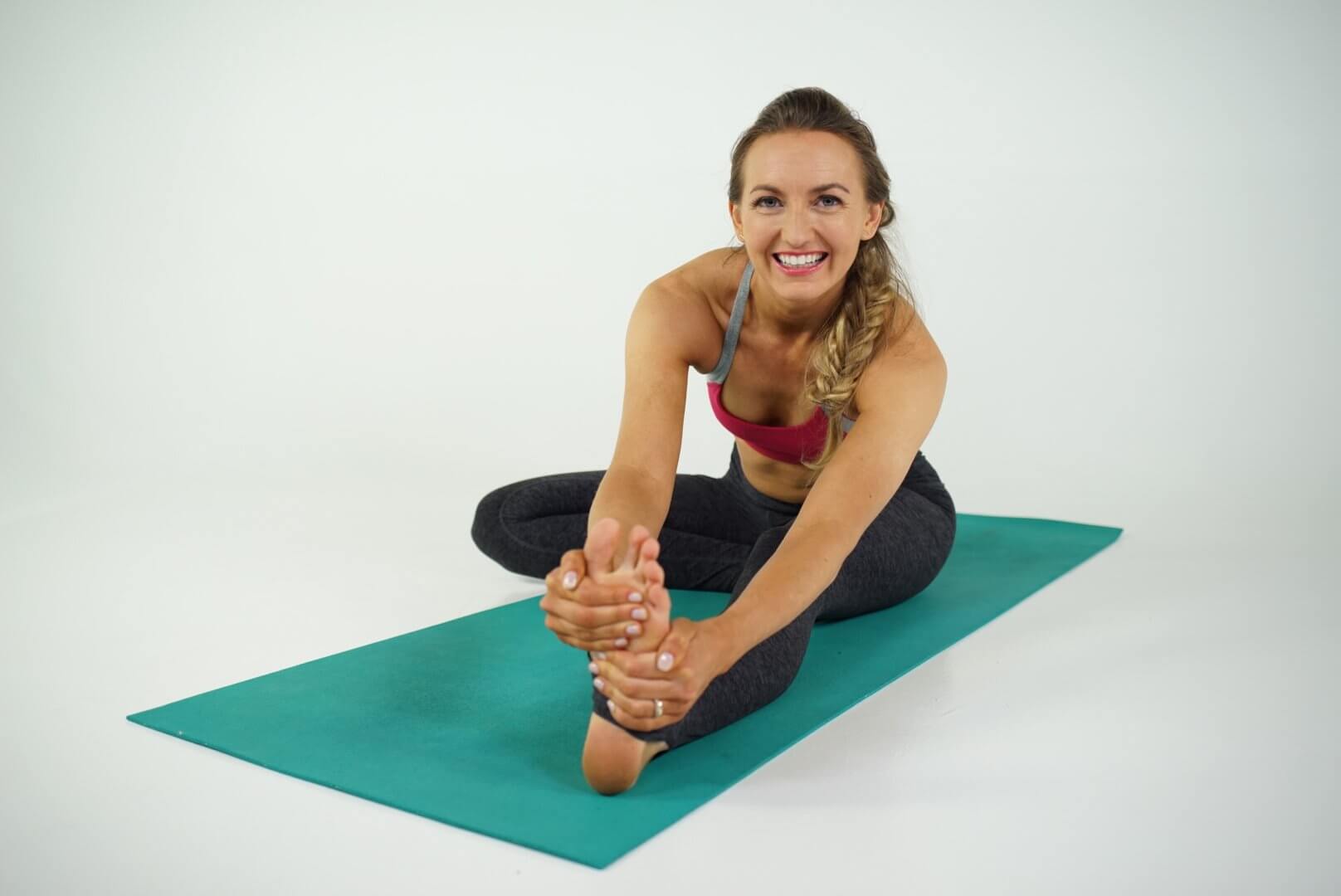
- Step 1: Sit upright on the Yoga mat, position yourself just in front of the sit bones so that you are fully grounded and stable. Fully extend the legs out in front of you.
- Step 2: Bend the left knee and draw the heel back into the perineum. Rest the sole of the left foot on the inner right thigh.
- Step 3: Inhale and lengthen the spine through the crown of the head, and exhale while folding forward over the right leg. Place the hands on the mat or hold the outer edges of the right foot.
- Step 4: Take care to keep the spine extended and straight over the right leg, but allow the mind, body and head to relax. Practice with the eyes closed and take full even deep breaths. Repeat on both sides.
Variation: It may feel better to use a bolster underneath the left knee if it isn’t grounded.
Benefits: Janu Shirshasana aids in blood circulation, along with extending and lengthening the spine. Yoga poses which release the build up of tension and stiffness in the back and neck can help as a treatment for migraine pain. Any Yoga postures which benefit blood circulation will aid those suffering from migraines.
Experience 3 Training Videos from Inside My 200-Hour Online YTT

Find more yoga sequences by benefit.
YOU MIGHT ALSO LIKE
- How to Teach Somatic Yoga: A Practical Guide for Instructors
- The Best Somatic Exercises for Grief: Find Healing Through Movement
- The Best Somatic Exercises for Anger Management and Emotional Release
- Authentic Pathways: Connecting With Higher Self for Inner Peace
- Yoga to Reconnect with Yourself: 5 Essential Practices for Inner Peace
- Yoga for Connection: 10 Poses to Deepen Relationships and Bonding
- Yoga To Connect With Your Body For Mind-Body Harmony
- Yoga to Connect with Feminine Energy: 5 Transformative Practices
- Yoga to Connect with Your Heart: 3 Poses for Emotional Balance
- Myofascial Release Yoga: Unlock Tension and Improve Flexibility
- 6 Hip Openers For Emotional Release
- Office Yoga: 10 Poses You Can Do Right Now
- Ayurveda Food Combining: The Key to Balanced Digestion
- Yoga For Grief: 8 Yoga Poses For Support
- Yoga for Vata Dosha: Practice Poses and Tips
Learn how to do 11 of the most popular yoga poses correctly. Free video + PDF download.










